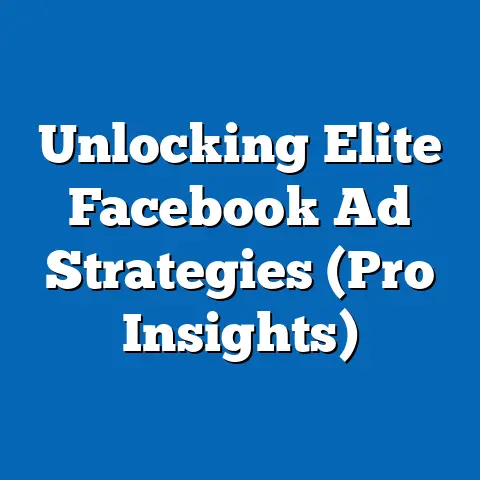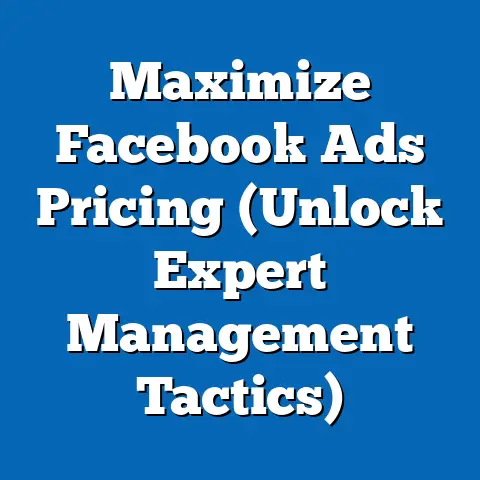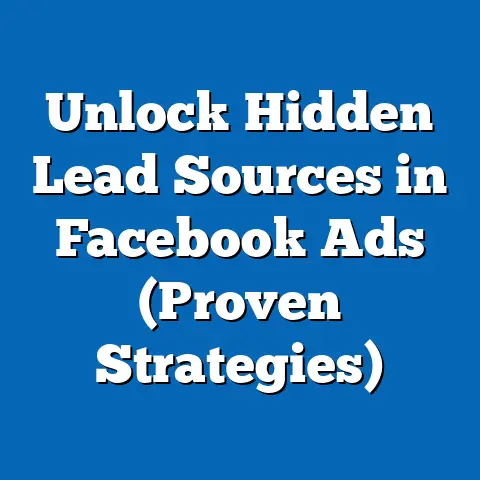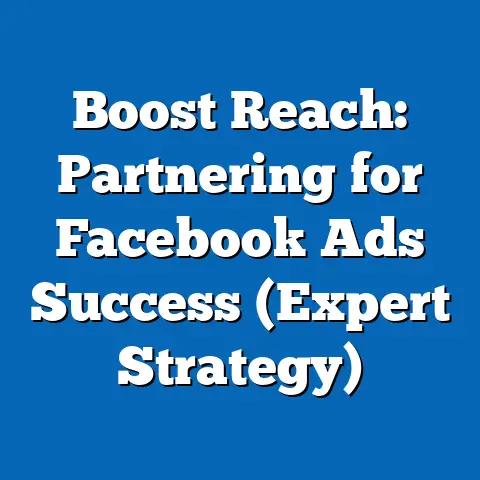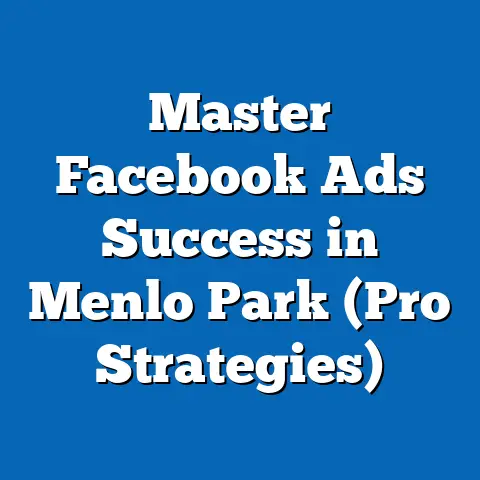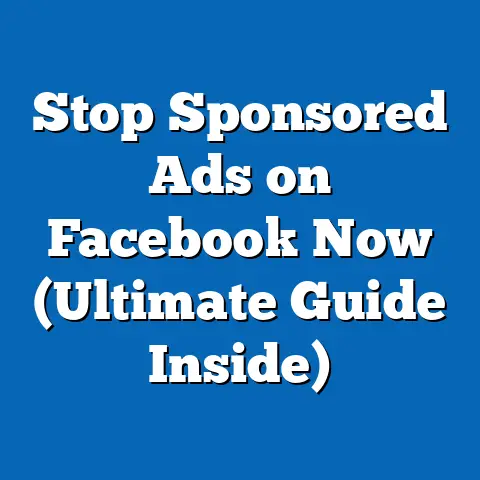Transform Facebook Ads Copy (Game-Changing Strategies)
As someone deeply immersed in the world of digital marketing, I’ve seen firsthand how the landscape of Facebook advertising is constantly evolving. Businesses today face a unique set of challenges and opportunities, making it more crucial than ever to stand out from the crowd. One of the most powerful ways to do this is through compelling ad copy that resonates with your audience, especially when considering the specific needs and contexts of different seasons or climates.
Think about it: a back-to-school campaign will have drastically different messaging than a summer promotion. The key is understanding how these environmental or seasonal factors influence consumer behavior and tailoring your ads accordingly. I’m going to walk you through some game-changing strategies that can transform your Facebook ad copy, boost engagement, and ultimately drive higher conversion rates. These aren’t just theoretical concepts; they’re tried-and-true techniques that I’ve used to help countless businesses achieve remarkable results with their Facebook ads.
Understanding Your Audience
Before you even begin to write a single word of copy, it’s essential to deeply understand your audience. This goes beyond just knowing their age, gender, and location. You need to delve into their interests, pain points, and motivations.
One aspect often overlooked is how climate-specific factors can influence consumer psychology and purchasing decisions. For example, in regions prone to extreme weather events, consumers may be more inclined to purchase emergency preparedness supplies or home insurance. Similarly, during the holiday season, people are naturally more receptive to ads that evoke feelings of warmth, nostalgia, and togetherness.
To gather this crucial data, I recommend utilizing Facebook Insights. This powerful tool provides a wealth of information about your audience, including their demographics, interests, behaviors, and even the types of content they engage with. You can also use other analytical tools, such as Google Analytics, to gain a more comprehensive understanding of your audience’s online behavior.
Here are a few practical tips for conducting audience research:
- Analyze your existing customer data: Look at past purchases, website activity, and customer feedback to identify trends and patterns.
- Create buyer personas: Develop detailed profiles of your ideal customers, including their demographics, interests, motivations, and pain points.
- Conduct surveys and polls: Directly ask your audience about their needs, preferences, and opinions.
- Monitor social media: Pay attention to what your audience is saying online, including their comments, reviews, and social media posts.
Takeaway: Thorough audience research is the foundation of effective Facebook ad copy. By understanding your audience’s needs, interests, and climate-specific context, you can craft ads that resonate with them on a deeper level.
Crafting Compelling Headlines
In the fast-paced world of social media, your headline is your first and often only chance to grab someone’s attention. It needs to be concise, engaging, and relevant to your target audience. Think of it as the digital equivalent of a storefront window – it needs to be enticing enough to make people stop and take a closer look.
When crafting headlines, consider the climate-specific needs of your audience. For example, if you’re running a promotion for winter coats, your headline might emphasize warmth, protection from the elements, or holiday gift ideas. On the other hand, if you’re promoting sunscreen during the summer months, your headline might focus on sun protection, beach vacations, or outdoor activities.
Here are some techniques for writing powerful headlines that address climate-specific needs:
- Use urgent calls to action: “Don’t wait! Get your winter coat before the snow hits!”
- Relate to seasonal references: “Get ready for summer with our new line of swimwear!”
- Highlight climate-specific benefits: “Stay cool and comfortable all summer long with our air conditioning services!”
- Ask a question: “Are you ready for the holiday season?”
- Make a bold statement: “The best sunscreen for your summer adventures!”
I’ve seen many ads fail simply because the headline was generic and uninspired. Don’t let that happen to you. Take the time to craft a headline that truly captures your audience’s attention and compels them to click.
Takeaway: Your headline is the most important part of your Facebook ad. Make it concise, engaging, and relevant to your audience’s climate-specific needs.
Utilizing Emotion in Copy
Humans are emotional beings, and our emotions play a significant role in our decision-making processes. That’s why emotional marketing can be so effective in Facebook ads. By tapping into your audience’s emotions, you can create a deeper connection and foster brand loyalty.
The key is to understand what emotions resonate with your audience and how to evoke them through your ad copy. For example, during the holiday season, people are often more receptive to ads that evoke feelings of nostalgia, warmth, and togetherness. On the other hand, during times of economic uncertainty, people may be more drawn to ads that offer reassurance, savings, and value.
Here are some examples of how to evoke emotions through climate-specific themes:
- Nostalgia: “Remember those carefree summer days? Relive the magic with our new collection of vintage-inspired swimwear!”
- Urgency: “Don’t miss out! Our winter sale ends soon!”
- Fear: “Protect your family from the flu this winter. Get your flu shot today!”
- Joy: “Celebrate the holidays with our festive collection of gifts!”
- Trust: “We’ve been keeping families warm for over 50 years. Trust us to provide the best heating solutions this winter.”
I remember working on a campaign for a local bakery during the holiday season. We focused on evoking feelings of nostalgia and warmth by featuring images of families gathered around the table, sharing freshly baked goods. The ad copy emphasized the tradition of baking during the holidays and how our bakery could help families create lasting memories. The results were phenomenal, with a significant increase in sales and brand engagement.
Takeaway: Emotions drive decisions. By understanding how to evoke the right emotions through your ad copy, you can create a deeper connection with your audience and drive better results.
Highlighting Benefits Over Features
One of the most common mistakes I see in Facebook ads is focusing on features rather than benefits. While it’s important to describe what your product or service does, it’s even more important to explain how it will improve your audience’s lives.
Think about it from the consumer’s perspective. They don’t care about the technical specifications of your product; they care about how it will solve their problems, make them feel better, or help them achieve their goals.
When framing benefits, consider how they resonate with your audience’s climate-specific needs. For example, if you’re selling energy-efficient windows, you might highlight how they can help consumers save money on their heating and cooling bills during extreme weather conditions. If you’re promoting eco-friendly products, you might emphasize how they can help consumers reduce their environmental impact and contribute to a more sustainable future.
Here are some examples of how to highlight benefits in a way that resonates with consumers’ climate-specific needs:
- Savings during economic downturns: “Save money on your energy bills this winter with our energy-efficient windows!”
- Eco-friendly product benefits: “Reduce your carbon footprint and protect the environment with our sustainable cleaning products!”
- Comfort during extreme weather: “Stay cool and comfortable all summer long with our powerful air conditioning system!”
- Protection from the elements: “Brave the winter weather with our durable and waterproof winter boots!”
Takeaway: Focus on benefits, not just features. Explain how your product or service will improve your audience’s lives, especially in relation to their climate-specific needs.
Incorporating Storytelling Techniques
Storytelling is one of the most powerful tools in a marketer’s arsenal. By weaving compelling narratives into your ad copy, you can capture your audience’s attention, build trust, and create a lasting impression.
The key is to craft stories that align with your brand messaging and values while also resonating with your audience’s climate-specific context. For example, you might share a story about how your product helped a customer overcome a challenge related to extreme weather conditions. Or, you might tell a story about your company’s commitment to sustainability and environmental responsibility.
Here are some examples of how to weave climate-specific narratives into your Facebook ads:
- Sustainability stories: “At [Your Company], we’re committed to protecting our planet. That’s why we use sustainable materials and ethical manufacturing practices. Learn more about our commitment to sustainability!”
- Customer success stories: “Meet [Customer Name], who used our product to prepare for a hurricane and protect her family. Read her inspiring story!”
- Behind-the-scenes stories: “Take a peek behind the scenes and see how we’re preparing for the winter season. We’re working hard to ensure you have everything you need to stay warm and comfortable!”
I’ve found that customer success stories are particularly effective. When potential customers see how your product or service has helped others overcome similar challenges, they’re more likely to trust your brand and make a purchase.
Takeaway: Storytelling is a powerful way to connect with your audience on a deeper level. Weave climate-specific narratives into your ad copy to enhance relatability and engagement.
Call to Action (CTA) Strategies
Your call to action (CTA) is the final piece of the puzzle. It’s the instruction that tells your audience what you want them to do next. A strong CTA can be the difference between a successful ad and a missed opportunity.
When crafting your CTA, consider your climate-specific goals and the needs of your audience. For example, if you’re running a summer promotion, your CTA might be “Shop Now for Summer Essentials.” If you’re promoting a winter sale, your CTA might be “Get Your Winter Gear Today.”
Here are some examples of strong CTAs that encourage immediate action:
- “Shop Now”
- “Learn More”
- “Sign Up Today”
- “Get Started”
- “Download Now”
- “Claim Your Discount”
The key is to make your CTA clear, concise, and compelling. It should be easy for your audience to understand what you want them to do and why they should do it.
Takeaway: Your CTA is the final instruction to your audience. Craft a CTA that aligns with your climate-specific goals and encourages immediate action.
A/B Testing Your Ad Copy
No matter how great your ad copy is, there’s always room for improvement. That’s why A/B testing is so important. By testing different ad copy variations, you can determine what resonates best with your audience and optimize your ads for maximum performance.
A/B testing involves creating two or more versions of your ad copy and then showing them to different segments of your audience. You can then track the performance of each version and see which one generates the best results.
Here are some best practices for testing different ad copy variations:
- Test one element at a time: This will help you isolate the impact of each change and determine what’s working and what’s not.
- Use a large enough sample size: This will ensure that your results are statistically significant.
- Track your results carefully: Monitor key metrics such as click-through rate, conversion rate, and cost per acquisition.
- Analyze your results and refine your copy: Use the data you collect to make informed decisions about how to improve your ad copy.
I often recommend testing different headlines, CTAs, and even the overall tone of your ad copy. You might be surprised at what resonates with your audience.
Takeaway: A/B testing is essential for optimizing your Facebook ad performance. Test different ad copy variations to determine what resonates best with your audience.
Conclusion
In the ever-evolving landscape of Facebook advertising, crafting compelling ad copy is more important than ever. By understanding your audience, utilizing emotion, highlighting benefits, incorporating storytelling, and crafting strong CTAs, you can transform your Facebook ads and drive better results.
Remember, the key is to continuously adapt your strategies to meet the changing needs of your audience, especially considering climate-specific contexts. By implementing the game-changing strategies outlined in this article, you can take your Facebook ads to the next level and achieve your marketing goals.
I encourage you to start experimenting with these strategies today. The world of Facebook advertising is constantly changing, and the only way to stay ahead of the curve is to be willing to learn, adapt, and innovate. So, go out there and transform your Facebook ads!

